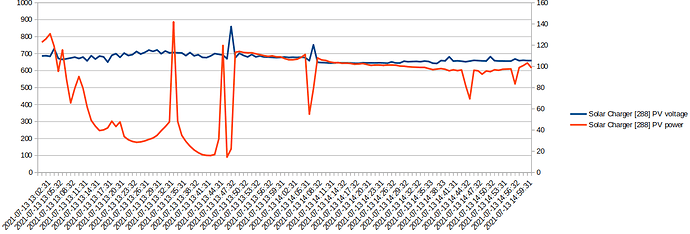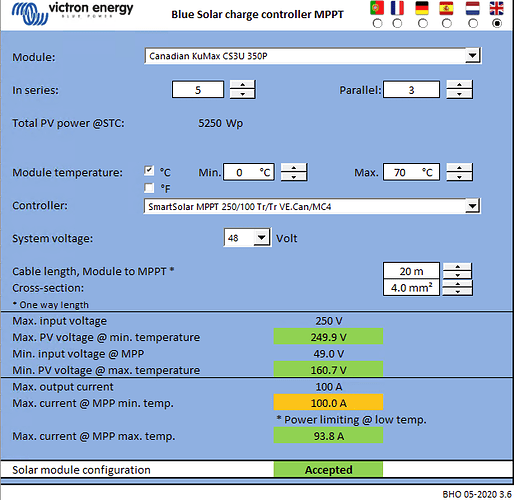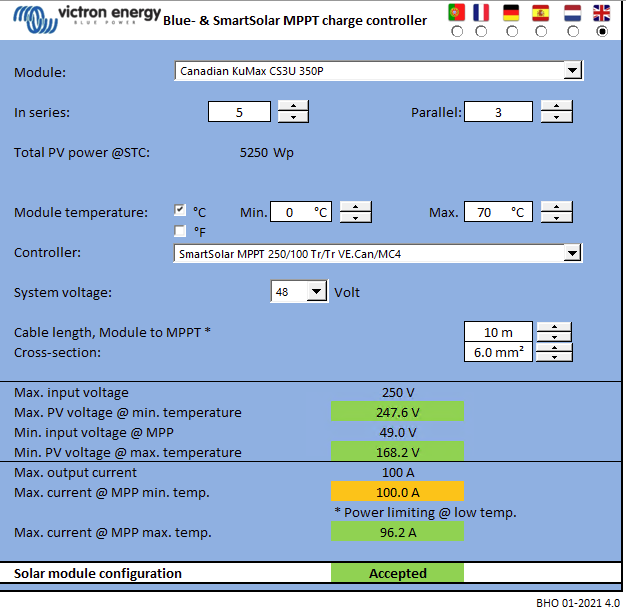Well that line of argument assumes the MPPT is never unloaded. But the MPPT does a scan periodically, which means every now and then it unloads the PV-array and allows the voltage to swing up for a few seconds.
I realize this, but again the devil is in the detail. Is that search, a complete unload or is it within a bandwidth?
If the MPPT design is wholistic and realizes that 145V+ causes the MPPT to self-protect, maybe it doesn’t venture there.
Again, I don’t know.
Outback MPPTs actually incorporate a “sort of” setting in this regard. Where you can decide if you want an entirely fresh search sweep or within boundaries of the existing power point.
This is to enable it to react quickly to small PV changes.
That will depend on what MPPT you use. A Victron MPPT does not completely unload. If you watch it, you will see it do three quick scans, each one a little wider (so the last one unloads it the most).
It also depends on what MPPT in the Victron stable you use. The lower end models handle overcurrent events in software. They simply restart from zero. Overcurrent events usually happens during cloud-flare conditions, so now we are again talking of unusually ideal conditions where it is cold, sunshine is bright, and there is some thin cloud cover.
Indeed. It would not venture there. As it unloads and the voltage passes past 145V, it should stop charging and wait for the voltage to drop down again.
OK, stop presses everyone.
I made some inquiries. There is no clamping in the blue MPPTs. If you exceed the design voltage, the hardware will be damaged.
I do apologise for the earlier incorrect information.
Yeah, that is how I have it too. Amps yes, not the volts. ![]()
@plonkster, Thanks for that.
Perhaps there is a Zener diode that will fit the bill.
@Louisvdw, there are also 66cell/132 half-cell panels on the market.
I haven’t seen them advertised in ZA though.
They seem to just hit the sweet spot.
And here I am calculating every strings VOC strictly down to 0 Deg with every install I do. Now I see it may have been a waste of time. 
It’s that friggin’ global warming causing all the cold 
Exactly.
One place heats up, the other place cools down. The NETT result the problem, as it is getting warmer overall.
One one many researching what is happening: Global Climate Report - January 2021 | National Centers for Environmental Information (NCEI)
Yup, but here half the people complain about the heat in Summer and the other half about the cold Winters - (in fact half our household too!) so we must have the perfect weather in SA
About 10 days ago I had a really nice cold spell. Just as an example of how you cannot necessarily assume your high voltage conditions is going to occur early in the morning. This one happened shortly before 2PM. Still only around 140V, but quite an outlier compared to the normal operating voltage which is in the mid-120s.
I plotted the power along with the voltage, so you can see it happened at a time when the MPPT was (likely) scanning.
What is generating the PV voltage at night?
How far South is Cape Town these days?
Edit: My bad I had minutes and hours confused.
Here’s another data point:
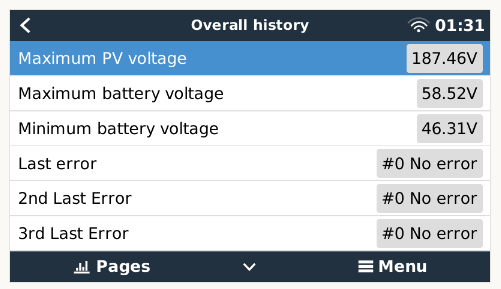
Located in Somerset West. The panels are Canadian Solar model CS3W 400W, north facing, 4 in series. According to the datasheet Voc is 47.2V at STC. In just over a year I have never reached that.
Mmmm … so I checked mine too, Canadian Kumax, 350w, 4 series 3 parallel, 46.6v:
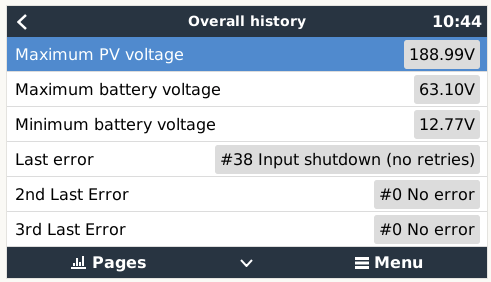
I also see that the new Excel calc has changed the max PV Voltage @ min temperature.
Version VE-MPPT-Calc-3_6: 249.9 v which has been driving my abundance of caution all these years.
Version VE-MPPT-Calc-4_0: 247.6v which makes it unnecessary.
Which makes me want to add 3 more panels … Hobby or Want … still deciding. cause there is a baby on the way, and reading what others have to go through with little ones, 4kw max the inverter can do, could become a Need.
